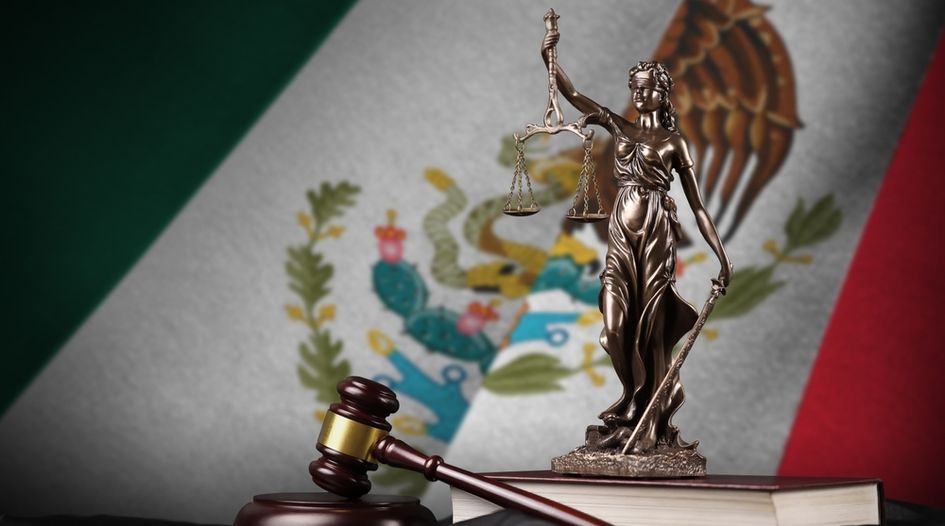Mexico: Refreshed regime takes aim at administrative infringements and criminal counterfeiting

This is an Insight article, written by a selected partner as part of WTR's co-published content. Read more on Insight
Legal framework
After entering into an agreement with the United States and Canada, Mexico reformed and even completely revised many of its domestic laws governing intellectual property rights and their enforcement. This included enacting the Federal Law for the Protection of Industrial Property (LFPPI), which entered into force on 5 November 2020, and significantly amending the Federal Copyright Law (LFDA), the Federal Criminal Code and other related procedural laws. These recent changes aim to provide better and more diverse legal mechanisms so that IP owners can better enforce and protect their intangible assets.
Under Mexican law, what most people name generically as ‘counterfeiting’ and ‘piracy’ are considered either administrative infringements of the specific IP rights involved (either trademarks, patents or copyrights) or criminal counterfeiting (applicable only to copyrights and trademarks). The procedure and action brought would depend on the circumstances of each case. This distinction entails different procedural rules and effects, which in turn significantly increase the burden of legal requirements for IP owners to obtain favourable results. Legal remedies that seek to stop trademark infringement are strongly linked to and are thus limited by the main legal causes that created them, whether administrative or criminal.
For these reasons, administrative infringement actions are brought and tried before the Mexican Institute of Industrial Property (IMPI) while criminal actions are brought before the General Prosecutor’s Office (FGR) as an investigative and prosecutorial authority. If there is sufficient evidence, this, in turn, can bring the case before a federal criminal judge after a formal indictment.
Border measures and customs enforcement
After a series of amendments and reforms to several federal laws, in December 2021, the General Customs Administration (AGA) was dissolved, and a new independent institution responsible for customs administration and control, the National Customs Agency of Mexico (ANAM), was created. This new government agency has assumed all the legal powers and responsibilities of the AGA but with broader legal customs enforcement and border protection powers. It has an essential role in enforcing intellectual property rights but, like its predecessor, the ANAM has no ex officio powers when dealing with IP infringement and may only act after a competent authority (the IMPI, the FGR or a judge) issues an order or warrant instructing it to take enforcement action. This lack of legal powers to take direct action makes it more difficult for IP rights holders to swiftly enforce and defend their rights.
Since 2011, however, Mexican customs authorities have operated a database of trademark owners that serves as a watchlist and a source of information that Customs officials can use to identify suspected infringing shipments. The aim is to pass information to other authorities and trademark owners or their registered representatives in Mexico so that they can lodge formal legal action to detain or seize shipments before they clear Customs.
Notwithstanding the lack of ex officio legal powers, measures taken at some customs offices (most notably at Manzanillo and Lazaro Cardenas seaports, which together handle more than 85% of the container shipments from China and Southeast Asia) are highly effective because of their significant impact and reasonable costs.
Such actions interrupt the supply chain of counterfeits at the final stage (while the offending merchandise awaits customs clearance) before they are distributed to final consumers, and usually involve vast volumes of counterfeit goods. This approach has resulted in the seizure of millions of counterfeit items, and, in some cases, has led to the arrest of traffickers.
Anti-counterfeiting customs and border control efforts depend on collaboration mechanisms between Mexican government agencies and trademark owners and their representatives. They also hinge on the ability to monitor and detect the import and export operations of counterfeit and infringing goods. They are further boosted by the commitment of trademark owners to undertake the appropriate legal measures within the short time frames available (a maximum of 72 hours in most cases) before shipments clear Customs.
Collaborative efforts with customs authorities should not depend exclusively on including a trademark in the customs database but should involve investing time and effort in working with customs officials to give them the required knowledge to identify counterfeit products. Training seminars and regular face-to-face contact with officials allow rights holders to demonstrate that they are prepared to invest in the relationship. This means that Customs’ interest will be more effectively engaged, increasing the likelihood of successful action. Nevertheless, this part of the process is sometimes overlooked. Customs authorities consist of thousands of people trying to do their jobs within the relevant legislation’s confines (and shortcomings). Officials must deal with a limited mandate, scarce resources and the ever-growing risk of being the target of organized crime violence.
It may be beneficial for rights holders to consider assigning resources to the education and awareness of customs and other law enforcement personnel. Active participation in seminars, training and forums where direct contact with officials is possible, should improve detection practices. In this regard, response times from rights holders are critical in maintaining a good relationship with law enforcement, as the success of the authorities’ actions often depends on how quickly rights holders respond and undertake the appropriate legal actions once a shipment of illegal goods has been detected.
Criminal prosecution
In more severe cases, where the violation has been caused by importing into the country, storing, transporting, distributing and selling objects that bear marks identical to those covered by a trademark registration or when unauthorised exploitation of copyrights is performed with criminal intent, a criminal complaint may be the best option available.
These actions are lodged before the FGR, which is competent to investigate such crimes and is legally empowered to request the necessary remedies (cautionary measures) before the competent courts.
After filing a claim and providing the available evidence, an FGR deputy prosecutor is responsible for the investigation, which is supposed to produce the necessary evidence to determine whether there is criminal trademark counterfeiting and unlawful copyright exploitation, and to request from the competent courts the legal remedies necessary to stop illegal conduct, including the seizure of offending products and evidence required to support the case.
Among the legal remedies available, search warrants can be requested before a judge to allow police to enter private premises to look for evidence and seize offending materials. These usually include the ability to secure the physical grounds (eg, the seizure of real estate) where the criminal conduct is taking place and to arrest those conducting it. In such matters, the police (under the command of the deputy attorney) are responsible for attesting to the existence of the sites where the counterfeits are being produced, distributed and sold.
One of the most welcome changes included in the LFPP is the substitution of FGR’s in-house expert witness report for an official technical opinion that is issued by the IMPI within 30 working days. It is through this opinion that the nature of the original products and the counterfeits is legally proven and a clear legal definition is given of what constitutes the criminal counterfeiting of registered trademarks.
If sufficient evidence is gathered, the deputy attorney submits the case before a competent judge. If a person or group of people are identified as responsible for the illegal conduct, an indictment is issued, evidence is submitted and examined by the court (this is when a criminal trial begins), and hearings are conducted until all evidence is examined and all formalities are exhausted.
Once the decision declaring the criminal liability of the people involved is definitive and irreversible (ie, once all judicial remedies and recourses have been exhausted), the owner or rights holder of the affected IP rights can file a request before a civil judge to recover damages. Such recovery implies a different civil procedure, although it is based on a criminal judgment.
Moreover, several circumstances at each stage of these procedures are beyond the control of the parties because the main responsibility of discovering and obtaining evidence, issuing the official legal briefs and demonstrating the conclusions necessary to start and support a criminal judicial procedure falls on the prosecutors. Consequently, IP rights holders should collaborate and assist the FGR at each stage. Nevertheless, it is almost impossible to estimate a precise time frame for criminal trials or to anticipate their results.
Administrative and civil enforcement
The Mexican legal system is sometimes labelled a hybrid system with respect to trademark infringement claims because the IMPI is an administrative authority that is legally competent to attend to and resolve claims, and is responsible for keeping the registry of IP rights such as trademarks and patents, before a court can intervene.
This situation directly affects how legal proceedings are carried out and the results that can be expected, since the IMPI is not a court. This is significant when the desired goal is to stop infringing conduct immediately and an aggressive approach is needed.
The IMPI can enforce IP rights by ordering provisional measures that usually precede an administrative declaration of infringement, which generally includes fines plus the definitive order to stop the infringing conduct. The IMPI may order:
- the withdrawal from circulation or a ban on the distribution of infringing merchandise;
- the seizure of infringing goods;
- the cessation of the infringing conduct either directly to the alleged infringer or to any third parties that participate or facilitate the conduct.
Finally, the IMPI may order the forceable closure of the infringer’s premises, and under the provisions included in the LFPPI it may impose and collect more significant fines (up to US$1.1 million). This should significantly shorten the time between sanctions being imposed and enforced.
Administrative infringement claims are usually brought when the actual infringement conduct consists of copying or using a trademark in a manner that is not identical but confusingly similar to a previously registered trademark to produce an association in the consumer’s mind and illegally gain benefits.
Further, administrative infringement claims can involve specific legal remedies ordered by the IMPI to cease the infringement and prevent further damage to the wronged party. Such remedies are foreseen in Mexican law as provisional measures and include:
- the order to immediately stop any or all the conducts considered to infringe the plaintiff’s trademark rights (similar to an injunction);
- withdrawal from the market of the infringing goods;
- the seizure of such goods performed by the ordering authority; and
- the closure of the establishment where the infringement is taking place.
In addition, before the IMPI orders any provisional measure, the law requires the plaintiff to produce collateral adequate to cover any damage that could be caused to the defendant. The amount of the guarantee is determined by the IMPI depending on the extent of the requested measures and the case’s specific circumstances. The usual practice is to post it before such authority in the form of a bond, deposit bill or a similar instrument before the provisional measures are granted.
Another meaningful change to the newly enacted LFPPI implies that an IP rights owner need no longer wait until an administrative infringement resolution is deemed final and definitive (the IMPI’s administrative resolutions can be challenged by nullity claims before the Federal Court of Administrative Justice and then by an amparo constitutional appeal before a circuit tribunal) to seek indemnification for the damages caused by the infringer, as the IMPI may now study and determine damages or if the plaintiff chooses to, take the damages claim to a civil judge, which again can be started even if the infringement resolution is not yet deemed as final and definitive.
Generally, it is essential to consider that administrative procedures before the IMPI are more formalistic and have some disadvantages, such as the obligation to post a bond on rights holders seeking seizures or the adoption of other provisional measures and the impossibility of seizing obvious counterfeits during official inspections due to the lack of an administrative complaint having already been filed by the rights owners.
Anti-counterfeiting online
Another welcome change introduced to the LFPPI and the amendments to the LFDA and related Mexican laws consists in the addition of specific legal provisions that regulate and punish conduct performed by the unlawful use of the Internet, specifically concerning the use of e-commerce to distribute merchandise or digital contents that infringe registered trademarks, patents or copyrights. These include the now-mandatory notice and takedown mechanism that has proved to be very effective in other jurisdictions.
Notwithstanding these advances, the question remains why – despite a growing number of provisions specifically addressing these matters and enabling authorities to act, plus the creation of highly specialised law enforcement units to combat online crimes, and the increasing public awareness – is the Internet still considered a haven for pirates and infringers? Internet piracy is complex and the authorities face many practical obstacles, including the public’s perceived tolerance of and consent towards ‘harmless illegal conduct’. The unfavourable situation could be summarised as a lack of resources of the authorities to investigate infringements and/or criminal offences thoroughly, plus the difficulty in exerting adequate means to combat the problem effectively (ie, how to remove the veil of anonymity surrounding most illegal activities happening on cyberspace).
In this context, the most valuable aspect of any strategy to combat counterfeiting in the digital domain involves performing comprehensive investigations and taking the legal actions available to combat online counterfeiters, paired with a digital isolation strategy. If a vendor of counterfeit goods is unable to reach their potential consumers sooner rather than later, that counterfeiter will be driven out of business.
Under these principles, it is worthwhile investing in periodic monitoring and evaluation (patrolling and investigating) of what is lurking on the different e-commerce sites (eg, MercadoLibre, Linio, eBay and Amazon), as well as specific social networks that have jumped on the bandwagon of offering their users the ability to sell merchandise on their platforms. Once counterfeits are identified, bringing takedown actions before the administrators of these websites and portals, plus other legal actions directed at the providers (ie, hosting companies) where the sites may be harboured, could effectively isolate counterfeiters without the need to seize and destroy the offending items.
Preventive measures/strategies
While it is impossible to implement actions to combat every aspect of counterfeiting and piracy, it is widely known that several countries in Southeast and East Asia (especially China) are the primary sources of most counterfeit products. It makes sense to begin here and obtain sensible intelligence and data concerning the routes of the cargo manufactured and shipped from the region to several strategic territories throughout the world.
A wise investment should aim to produce legal actions (eg, claims and raids) one step before the very end of the supply chain, where counterfeit goods are sorted just before the final selling point, and gather the necessary information and evidence to discover the source of the products. This should also help direct further legal action towards the places of origin (manufacture), distribution and wholesale of illegal goods.
Another critical aspect to bear in mind when obtaining information is that counterfeiters’ mechanisms and logistics are becoming increasingly sophisticated. The means used to obtain valuable data regarding the location of warehouses, and means of transportation and distribution should be equally capable of producing the desired results.
Those who invest in security measures such as alarms, safe boxes and guards to protect their valuable assets when crime rates increase are less likely to suffer losses than those who do not spend resources on such measures. Victims of robbery rarely recover their property.
It is essential to acknowledge that those involved in counterfeiting usually see their activities as a business and will only be willing to devote their resources if they perceive that their investment will be profitable and carry little risk. If a rights holder has shown a relentless commitment to enforcing and protecting its IP rights, most counterfeiters will be reluctant to start carrying the merchandise of that specific brand, compared with other brands that are known not to enforce their IP rights. Consequently, legal actions should be well publicised to reinforce the general perception of their rights holders’ strict enforcement of IP rights, and backed up by the actions themselves.




